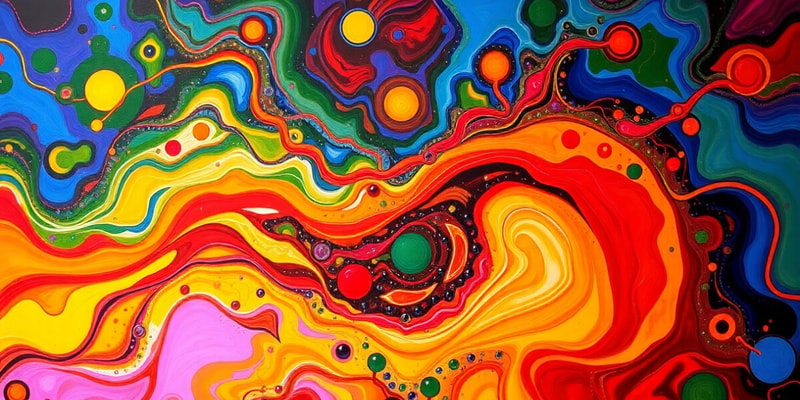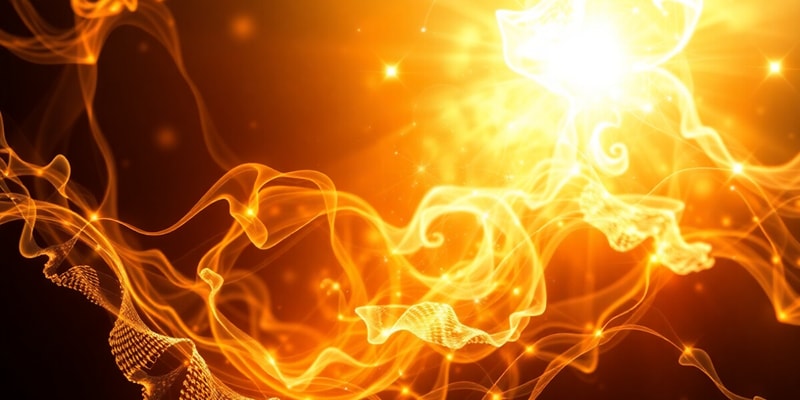Podcast
Questions and Answers
What does bioenergetics primarily study?
What does bioenergetics primarily study?
Which form of energy is associated with motion?
Which form of energy is associated with motion?
What type of reaction is photosynthesis classified as?
What type of reaction is photosynthesis classified as?
Which statement correctly describes an anabolic pathway?
Which statement correctly describes an anabolic pathway?
Signup and view all the answers
What is the primary energy-carrying molecule in cells?
What is the primary energy-carrying molecule in cells?
Signup and view all the answers
Which of the following processes is an example of a catabolic reaction?
Which of the following processes is an example of a catabolic reaction?
Signup and view all the answers
What occurs when ATP is broken down in a cell?
What occurs when ATP is broken down in a cell?
Signup and view all the answers
In which type of reaction is energy released?
In which type of reaction is energy released?
Signup and view all the answers
Where do the light-independent reactions of photosynthesis occur?
Where do the light-independent reactions of photosynthesis occur?
Signup and view all the answers
Which of the following substances is used by plants to absorb carbon dioxide?
Which of the following substances is used by plants to absorb carbon dioxide?
Signup and view all the answers
What is the end product of glycolysis?
What is the end product of glycolysis?
Signup and view all the answers
What is produced during the Krebs cycle for each turn?
What is produced during the Krebs cycle for each turn?
Signup and view all the answers
What is the primary role of the electron transport chain in cellular respiration?
What is the primary role of the electron transport chain in cellular respiration?
Signup and view all the answers
Which molecule acts as the final electron acceptor in the electron transport chain?
Which molecule acts as the final electron acceptor in the electron transport chain?
Signup and view all the answers
During glycolysis, how many ATP molecules are generated as a net yield?
During glycolysis, how many ATP molecules are generated as a net yield?
Signup and view all the answers
Which step of cellular respiration occurs in the cytoplasm?
Which step of cellular respiration occurs in the cytoplasm?
Signup and view all the answers
What is the primary function of chlorophyll in the photosynthesis process?
What is the primary function of chlorophyll in the photosynthesis process?
Signup and view all the answers
Which of the following are the reactants used in photosynthesis?
Which of the following are the reactants used in photosynthesis?
Signup and view all the answers
What color pigments do carotenoids primarily contribute to plants?
What color pigments do carotenoids primarily contribute to plants?
Signup and view all the answers
What is produced during the light-dependent reactions of photosynthesis?
What is produced during the light-dependent reactions of photosynthesis?
Signup and view all the answers
What is the main purpose of the Calvin Cycle in photosynthesis?
What is the main purpose of the Calvin Cycle in photosynthesis?
Signup and view all the answers
Which pigment is responsible for the reddish color in red algae?
Which pigment is responsible for the reddish color in red algae?
Signup and view all the answers
Which of the following statements about chlorophyll and sunlight in photosynthesis is true?
Which of the following statements about chlorophyll and sunlight in photosynthesis is true?
Signup and view all the answers
Study Notes
Bioenergetics
- Bioenergetics is the study of energy in living systems and the organisms that utilize them.
- Living things require energy.
- Energy is the ability to do work.
- All living things require energy.
- Energy can be transformed from one form to another.
Types of Energy
- Kinetic Energy: Energy of motion. Examples include heat and light.
- Potential Energy: Energy of position. Includes energy stored in chemical bonds.
Forms of Energy Conversion
- Solar, chemical, and mechanical are ways energy can be converted from one form to another.
Energy Reactions
- Endergonic Reactions: Chemical reactions that require a net input of energy (e.g., photosynthesis).
- Exergonic Reactions: Chemical reactions that release energy (e.g., cellular respiration).
Photosynthesis
-
The process by which plants and some other organisms use sunlight to synthesis foods from carbon dioxide and water.
-
Photosynthesis converts light energy into chemical energy.
-
The process fuels the metabolism of photosynthetic organisms.
-
The process creates glucose from sunlight, carbon dioxide, and water.
-
Photosynthesis takes place in the leaves, specifically inside chloroplasts.
-
Chlorophyll, a green photosynthetic pigment, absorbs sunlight.
-
Chlorophyll is not used up or created in the process.
-
Other pigments, like carotenoids, may also be present and impact leaf colour.
-
Photosynthesis occurs in two main stages:
- Light-dependent reactions occur in the thylakoid membranes.
- Light-independent reactions occur in the stroma.
-
Reactants: Carbon dioxide and water are used. Sunlight is needed but not consumed in the process. Chlorophyll is not used up or created.
-
Products: Oxygen and glucose are created.
-
Plants absorb carbon dioxide through tiny pores called stomata.
-
Different pigments can absorb and reflect different wavelengths of visible light, giving leaves varied colours.
Cellular Respiration
-
The process by which cells release the stored energy in sugar to make ATP.
-
This occurs in the cytoplasm and mitochondria.
-
The general formula for cellular respiration is: C6H12O6 + 6O2 → 6CO2 + 6H2O + ATP
-
Cellular respiration occurs in three stages:
- Glycolysis
- Krebs Cycle
- Electron Transport Chain
-
Glycolysis: Breaks down glucose into two molecules of pyruvate.
-
Krebs Cycle: Uses acetyl coenzyme A to produce ATP, NADH, and FADH2, releasing carbon dioxide.
-
Electron Transport Chain: Creates a large amount of ATP from the NADH and FADH2 produced in the Krebs Cycle. This stage uses oxygen and releases water
-
The current balance of oxygen and carbon dioxide in the atmosphere is maintained by photosynthesis and respiration.
-
Plants carry out photosynthesis, taking in carbon dioxide and releasing oxygen.
-
Animals and other organisms carry out respiration, taking in oxygen and releasing carbon dioxide.
Studying That Suits You
Use AI to generate personalized quizzes and flashcards to suit your learning preferences.
Related Documents
Description
Test your knowledge on bioenergetics, the study of energy within living organisms. This quiz covers types of energy, forms of energy conversion, and energy reactions such as photosynthesis and cellular respiration. See how well you understand the fundamental concepts of energy in biological systems.




